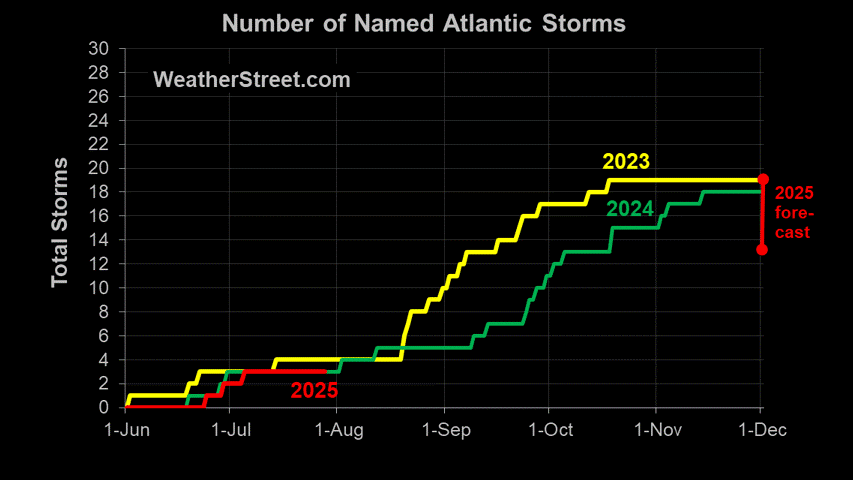N Atlantic: Storm Alert issued at 22 Aug, 2011 9:00 GMT
Hurricane IRENE (AL09) is forecast to strike land to the following likelihood(s) at the given lead time(s):
Red Alert Country(s) or Province(s)
Puerto Rico
probability for CAT 1 or above is 95% currently
probability for TS is 100% currently
the Dominican Republic
probability for CAT 1 or above is 40% within 9 hours
probability for TS is 100% within 9 hours
Red Alert City(s) and Town(s)
San Juan (18.4 N, 66.1 W)
probability for CAT 1 or above is 95% currently
probability for TS is 100% currently
Yellow Alert Country(s) or Province(s)
the Virgin Islands
probability for TS is 90% currently
the British Virgin Islands
probability for TS is 85% currently
Haiti
probability for CAT 1 or above is 15% in about 33 hours
probability for TS is 70% in about 33 hours
the Bahamas
probability for CAT 1 or above is 15% in about 33 hours
probability for TS is 70% in about 33 hours
the Turks & Caicos Islands
probability for CAT 1 or above is 10% in about 33 hours
probability for TS is 70% in about 33 hours
Cuba
probability for CAT 1 or above is 15% in about 45 hours
probability for TS is 55% in about 45 hours
the United States
probability for CAT 1 or above is 10% in about 93 hours
probability for TS is 25% in about 69 hours
Yellow Alert City(s) and Town(s)
San Francisco De Macoris (19.3 N, 70.3 W)
probability for CAT 1 or above is 20% in about 21 hours
probability for TS is 85% in about 21 hours
Grand Turk (21.5 N, 71.1 W)
probability for CAT 1 or above is 10% in about 33 hours
probability for TS is 70% in about 21 hours
Monte Cristi (19.8 N, 71.6 W)
probability for CAT 1 or above is 15% in about 33 hours
probability for TS is 70% in about 33 hours
Santo Domingo (18.5 N, 69.9 W)
probability for CAT 1 or above is 15% in about 21 hours
probability for TS is 65% in about 21 hours
Nassau (25.1 N, 77.4 W)
probability for CAT 1 or above is 10% in about 69 hours
probability for TS is 45% in about 69 hours
Jacksonville (30.3 N, 81.7 W)
probability for CAT 1 or above is 10% in about 117 hours
probability for TS is 20% in about 93 hours
Miami (25.8 N, 80.3 W)
probability for CAT 1 or above is 10% in about 93 hours
probability for TS is 25% in about 69 hours
Green Alert City(s) and Town(s)
Port-au-Prince (18.5 N, 72.3 W)
probability for TS is 40% in about 33 hours
Santiago De Cuba (20.0 N, 75.8 W)
probability for TS is 35% in about 69 hours
Note that
Red Alert (Severe) is CAT 1 or above to between 31% and 100% probability.
Yellow Alert (Elevated) is CAT 1 or above to between 10% and 30% probability, or TS to above 50% probability.
Green Alert (Low) is TS to between 31% and 50% probability.
CAT 1 means Hurricane strength winds of at least 74 mph, 119 km/h or 64 knots 1-min sustained.
TS means Tropical Storm strength winds of at least 39 mph, 63 km/h or 34 knots 1-min sustained.
For graphical forecast information and further details please visit
http://www.tropicalstormrisk.com/
This alert is provided by Tropical Storm Risk (TSR) which is sponsored by UCL, Aon Benfield, RSA Insurance Group, Crawford & Company and Aon Benfield UCL Hazard Research Centre.




 TOMORROW EVENING (FRI): Intensifying over the open sea...tracking North slowly...about 342 km SSW of Iwo To (formerly Iwo Jima) [8PM AUG 26: 22.1N 139.7E @ 100kph].
TOMORROW EVENING (FRI): Intensifying over the open sea...tracking North slowly...about 342 km SSW of Iwo To (formerly Iwo Jima) [8PM AUG 26: 22.1N 139.7E @ 100kph].






